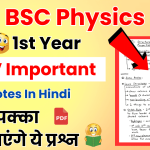The IIT entrance exams are known for their challenging questions, and solving previous year question papers can be a game-changer for your preparation. In this section, we’ll explore 50 sample questions and answers across different subjects to help you get a feel for the kind of questions you might encounter. These questions are designed to improve your understanding and test your preparation.
Physics
Question 1:
What is the work-energy theorem and how does it relate to the conservation of mechanical energy?
Answer:
The work-energy theorem states that the work done by all the forces acting on a particle is equal to the change in its kinetic energy. This ties into mechanical energy conservation, where in an isolated system, the total mechanical energy (kinetic + potential) remains constant if no external work is done.
Question 2:
Explain the concept of electric potential energy and its significance in the context of electric fields.
Answer:
Electric potential energy is the energy stored in an electric field due to the position of a charge within the field. It is significant because it helps determine how charges will move within the field, and it plays a role in circuits, capacitors, and other electrical systems.
Question 3:
How does Newton’s third law apply to action and reaction forces?
Answer:
Newton’s third law states that for every action, there is an equal and opposite reaction. This means that when one object exerts a force on another, the second object exerts an equal force in the opposite direction. This is crucial in understanding interactions between objects like rockets and airplanes.
Question 4:
What is the difference between scalar and vector quantities?
Answer:
A scalar quantity has only magnitude, such as temperature or mass, while a vector quantity has both magnitude and direction, such as velocity or force.
Question 5:
Explain the principle of superposition of waves.
Answer:
The principle of superposition states that when two or more waves overlap, the resultant displacement at any point is the algebraic sum of the displacements of the individual waves.
Chemistry
Question 6:
What is the significance of the atomic number in determining the identity of an element?
Answer:
The atomic number is the number of protons in the nucleus of an atom, and it determines the element’s identity. Each element has a unique atomic number.
Question 7:
How do catalysts affect the rate of a chemical reaction?
Answer:
Catalysts increase the rate of a chemical reaction by lowering the activation energy required, making it easier for reactants to reach the transition state and form products.
Question 8:
Describe the process of ionic bonding and give an example.
Answer:
Ionic bonding occurs when electrons are transferred from one atom to another, creating ions. The oppositely charged ions are attracted to each other. A classic example is sodium chloride (NaCl), where sodium gives up an electron to chlorine.
Question 9:
What is the difference between an exothermic and endothermic reaction?
Answer:
An exothermic reaction releases energy, usually in the form of heat, while an endothermic reaction absorbs energy from its surroundings.
Question 10:
What is Le Chatelier’s principle and how does it apply to equilibrium reactions?
Answer:
Le Chatelier’s principle states that if a system at equilibrium is disturbed, the system will shift its position to counteract the disturbance. For example, increasing the concentration of reactants will shift the equilibrium towards the products.
Mathematics
Question 11:
What is the fundamental theorem of algebra?
Answer:
The fundamental theorem of algebra states that every non-constant polynomial equation has at least one complex root. This means that any polynomial of degree n has exactly n roots, counting multiplicities.
Question 12:
Explain the difference between permutations and combinations.
Answer:
Permutations refer to the arrangement of objects where the order matters, while combinations refer to the selection of objects where the order does not matter. For example, the arrangement of books on a shelf is a permutation, while choosing a group of friends is a combination.
Question 13:
What is the derivative of a function and how is it used in calculus?
Answer:
The derivative of a function represents the rate of change of the function’s output with respect to its input. It is used to find the slope of a curve at any given point and is essential in understanding motion, growth rates, and optimization problems.
Question 14:
What are the key properties of quadratic equations?
Answer:
Quadratic equations are of the form ax² + bx + c = 0. They have two solutions, which can be found using the quadratic formula. The discriminant (b² – 4ac) determines the nature of the roots: real and distinct, real and equal, or complex.
Question 15:
How do you solve a system of linear equations using matrices?
Answer:
A system of linear equations can be represented as a matrix equation. By using matrix operations like Gaussian elimination or finding the inverse of a coefficient matrix, you can solve for the unknowns in the system.
Biology
Question 16:
What is the role of mitochondria in the cell?
Answer:
Mitochondria are known as the powerhouse of the cell. They generate most of the cell’s supply of adenosine triphosphate (ATP), used as a source of chemical energy.
Question 17:
What is the difference between prokaryotic and eukaryotic cells?
Answer:
Prokaryotic cells do not have a nucleus or other membrane-bound organelles, while eukaryotic cells have a well-defined nucleus and various organelles like mitochondria and the endoplasmic reticulum.
Question 18:
Explain the process of photosynthesis in plants.
Answer:
Photosynthesis is the process by which plants convert light energy into chemical energy. Using chlorophyll in their cells, plants absorb light and use it to convert carbon dioxide and water into glucose and oxygen.
Question 19:
What are enzymes and how do they work in the body?
Answer:
Enzymes are proteins that act as catalysts in biochemical reactions, speeding up reactions by lowering the activation energy. They are essential for processes like digestion and metabolism.
Question 20:
How does DNA replication occur?
Answer:
DNA replication is the process by which a cell makes an identical copy of its DNA. The double helix unwinds, and each strand serves as a template for a new complementary strand, facilitated by enzymes like DNA polymerase.
These sample questions and answers should give you a broad understanding of the types of questions you might encounter in the IIT exams. Practicing with these will not only help reinforce key concepts but also improve your problem-solving skills. Make sure to approach your preparation with dedication and consistency, as the IIT exams are all about mastering the fundamentals and applying them to challenging scenarios.
Top Indian Books for IIT Genius Previous Year Question Papers: A Comprehensive Guide
-
IIT JEE Previous Years’ Solved Papers – by Arihant Experts (Arihant Publications)
Content: This book features a collection of solved IIT JEE papers from previous years, along with detailed explanations for every question. It covers subjects like Physics, Chemistry, and Mathematics, and helps in understanding the pattern and difficulty level of the exam. -
IIT JEE Previous Year Solved Papers (2019-2002) – by MTG Editorial Board (MTG Learning Media)
Content: Includes solved papers for both JEE Mains and Advanced. It gives a good mix of easy, medium, and difficult questions to help students gauge their preparation level and improve their time management skills. -
Objective Physics for JEE Main & Advanced (Volume 1 & 2) – by DC Pandey (Arihant Publications)
Content: This book contains objective questions from past IIT JEE exams with clear and concise solutions. It helps in mastering concepts of Physics, which are critical for cracking the exam. -
Problems in General Physics – by I.E. Irodov (Pearson Education)
Content: Focuses on Physics problems from previous years with advanced-level questions. Best suited for students aiming to strengthen their conceptual understanding and problem-solving abilities. -
Chemistry for JEE Advanced – by R.K. Gupta (Cengage Learning India)
Content: A comprehensive guide for Chemistry, with a special focus on Organic, Inorganic, and Physical Chemistry. It includes a lot of previous year questions, providing deep insights into the types of questions expected in the exam. -
IIT JEE Mathematics (Previous Year Questions) – by R.D. Sharma (Dhanpat Rai Publications)
Content: A detailed collection of Mathematics questions from previous IIT JEE exams, with solutions and explanations. This book helps students prepare for the most frequently asked types of questions in the exam. -
IIT JEE Main & Advanced Physics – by H.C. Verma (Bharati Bhawan Publishers)
Content: Provides a mix of theoretical concepts and practice questions. The previous year IIT questions are included, along with detailed explanations and step-by-step solutions. -
Organic Chemistry for JEE Main & Advanced – by M.S. Chouhan (Arihant Publications)
Content: Specifically focuses on organic chemistry with previous IIT JEE questions, which are important for students preparing for both JEE Mains and Advanced exams. -
Mathematics for Class 11 & 12 (IIT JEE) – by R.S. Agarwal (S. Chand Publishing)
Content: This series of books covers mathematics in-depth, with special attention to the most common question types asked in IIT JEE. It also contains solved examples and previous year’s questions. -
IIT JEE Physics Problem Book – by D.C. Pandey (Arihant Publications)
Content: An essential book for IIT aspirants, this book provides a wide variety of solved and unsolved questions on Physics from the previous IIT JEE exams, focusing on problem-solving techniques. -
IIT JEE Advanced Chemistry – by O.P. Tandon (G.R. Books)
Content: Contains previous year’s questions along with important concepts and practice problems. This book is beneficial for students preparing for both the Mains and Advanced levels of IIT JEE. -
IIT JEE Mathematics (Trigonometry) – by S.L. Loney (Arihant Publications)
Content: A specific focus on Trigonometry, with previous IIT JEE questions and detailed explanations to help students master this key topic. -
Advanced Problems in Organic Chemistry for JEE – by M.S. Chouhan (Arihant Publications)
Content: This book specializes in organic chemistry and focuses on advanced-level questions and solutions, including previous year questions that challenge students to apply their knowledge. -
Problems in Physical Chemistry for JEE – by N.A. P. Khanna (Dhanpat Rai & Co.)
Content: It deals with previous IIT JEE problems in physical chemistry, providing a wide range of problems and conceptual discussions for better exam preparation. -
IIT JEE Physics Masterclass – by H.C. Verma (Bharati Bhawan Publishers)
Content: Aimed at mastering Physics for JEE, it features a blend of theory, practice questions, and IIT JEE previous year problems to ensure thorough preparation. -
Comprehensive Chemistry for JEE Main & Advanced – by J.D. Lee (Wiley India)
Content: A comprehensive resource for chemistry, focusing on both inorganic and organic sections with previous IIT JEE questions. Detailed problem-solving strategies are included. -
IIT JEE Mathematics (Integral Calculus) – by G.N. Berman (Arihant Publications)
Content: This book delves deep into integral calculus, focusing on problems from past IIT JEE exams, helping students improve their speed and accuracy. -
Physical Chemistry for JEE – by P.W. Atkins (Oxford University Press)
Content: Focuses on Physical Chemistry with a detailed explanation of the concepts and a collection of previous year’s IIT questions for practice. -
IIT JEE Advanced (Mathematics) – by Vikas Gupta (Cengage Learning India)
Content: Provides solutions to problems from IIT JEE Advanced exams, focusing on various mathematical concepts and previous year problems for practice. -
IIT JEE Advanced Physics: Part 1 – by D.C. Pandey (Arihant Publications)
Content: This volume covers important concepts and questions from Physics that have appeared in previous IIT JEE Advanced exams, providing clear and concise solutions.
These books are perfect companions for your IIT preparation, offering a variety of problems, detailed solutions, and an extensive collection of past questions to sharpen your skills and boost your confidence for the exams.
IIT Genius Previous Year Question Papers: A Key to Cracking the Exam
When it comes to cracking the IIT entrance exams, every aspirant looks for ways to boost their preparation. Among the most effective strategies is practicing with IIT Genius previous year question papers. These papers are a treasure trove of insights, offering a clear understanding of the exam pattern, level of difficulty, and types of questions. By practicing with these papers, students can enhance their problem-solving skills, manage time better, and improve their overall confidence.
IIT Genius previous year question papers are not just a set of random questions but a structured approach to mastering the subjects that matter. They cover all three critical subjects—Physics, Chemistry, and Mathematics—allowing you to practice every aspect of the exam. These papers simulate the actual test environment, helping you understand the flow of questions and adapt to the pressure of time constraints.
Why Practice IIT Genius Previous Year Question Papers?
-
Understanding the Exam Pattern: IIT JEE is known for its unpredictable nature, and the previous year’s papers give you a glimpse of how the questions are framed. Whether it’s the difficulty level or the types of questions, you’ll find every kind of question in these papers. By practicing, you can fine-tune your strategy for tackling each section of the exam.
-
Mastering Time Management: The IIT exam is all about managing time effectively. Previous year papers help you gauge how much time you should allocate to each section and how to pace yourself throughout the exam. Practicing regularly will improve your speed without compromising accuracy, a crucial skill to excel in IIT JEE.
-
Identifying Important Topics: By solving IIT Genius previous year question papers, you can identify recurring topics that hold high weight in the exam. This helps you focus your preparation on the most relevant areas, making your study sessions more productive. Whether it’s the laws of motion in Physics or Organic Chemistry in Chemistry, these papers give you a clear idea of what to prioritize.
-
Improving Accuracy: Solving previous year question papers allows you to sharpen your problem-solving techniques. With repeated practice, you become more adept at solving complex problems accurately and quickly. This boost in precision can make a big difference in your overall score.
-
Boosting Confidence: The more you practice, the more confident you become. Previous year papers prepare you for any surprises the exam might hold. As you solve each paper, you become familiar with the format, gain mastery over difficult topics, and build the mental stamina required for the exam.
FAQ for IIT Genius Previous Year Question Papers
1. Why are previous year question papers important for IIT JEE preparation?
Previous year question papers offer an in-depth understanding of the exam pattern, help you manage your time effectively, and allow you to identify key areas that require more focus. Practicing these papers also boosts your accuracy and confidence for the exam day.
2. How can I use IIT Genius previous year question papers for effective preparation?
You can use these papers to assess your current preparation level, identify weak areas, and practice problem-solving under time constraints. It’s advisable to solve one paper at a time, analyze your mistakes, and then revise the topics that need improvement.
3. Are the IIT Genius previous year question papers available for all subjects?
Yes, previous year question papers are available for all the major subjects in the IIT JEE: Physics, Chemistry, and Mathematics. They cover all important topics and give you a comprehensive understanding of what to expect in the exam.
4. Should I solve IIT Genius papers before completing my syllabus?
It is advisable to solve these papers after completing a significant portion of your syllabus. This will help you assess how well you’ve understood the topics and what areas need further attention.
5. How often should I solve previous year question papers during my preparation?
You should solve one to two previous year question papers each week as your exam approaches. Gradually increase the frequency to daily practice in the final weeks leading up to the exam.
Latest Posts
- Step-by-step guide to download and apply for jee mains admit card 202
- Comprehensive 2025 government holidays and recruitment details for job seekers
- JEE Mains Admit Card 2025: Your Step-by-Step Guide to Downloading the Hall Ticket
- Everything You Need to Know About 2025 Government Holidays Recruitment
- Comprehensive Guide to rrb d group recruitment 2025 – Eligibility, Vacancies, and Application
- Detailed guide to nps trust recruitment 2025 vacancies, eligibility and apply process
- Comprehensive guide to hpcl recruitment 2025 notification, vacancies, and application process
- ignou bed admission 2025 complete recruitment guide with eligibility and process
- Comprehensive Guide to Indian Army Agniveer Recruitment 2025 Notification and Jobs
- Everything You Must Know About CBSE Board Exams 2025 Changes & New Rules




